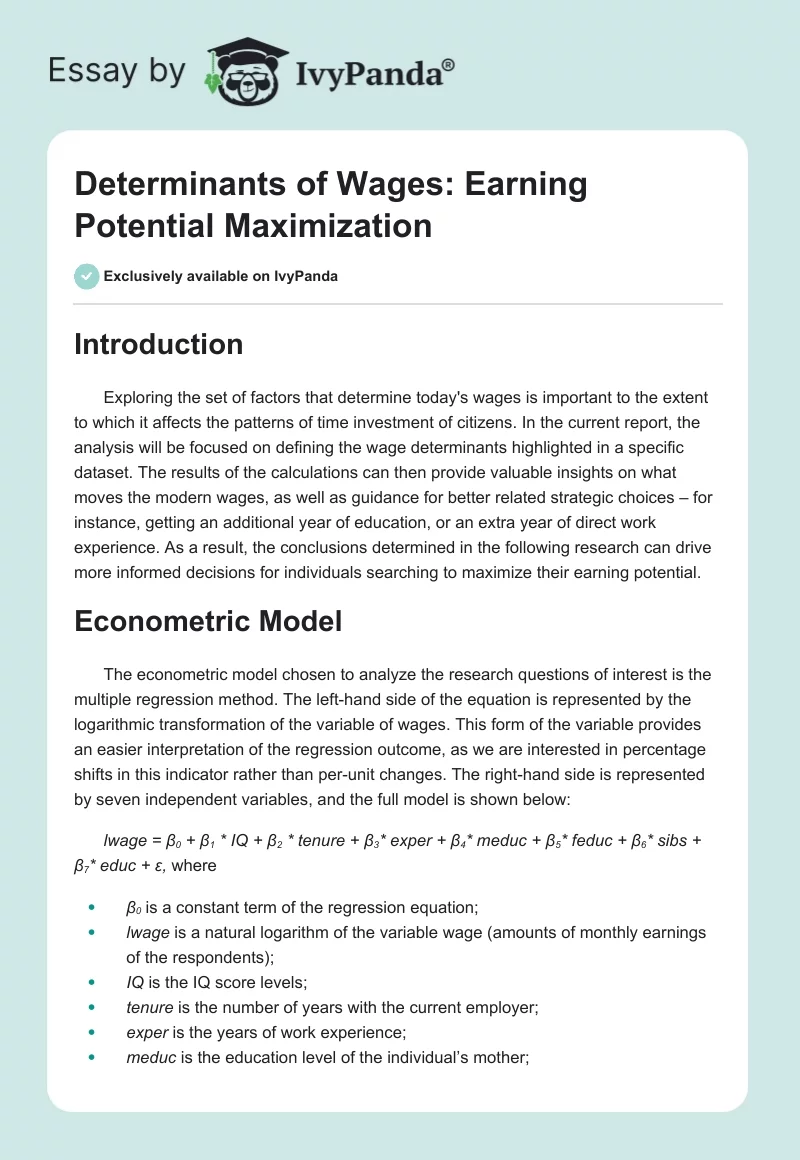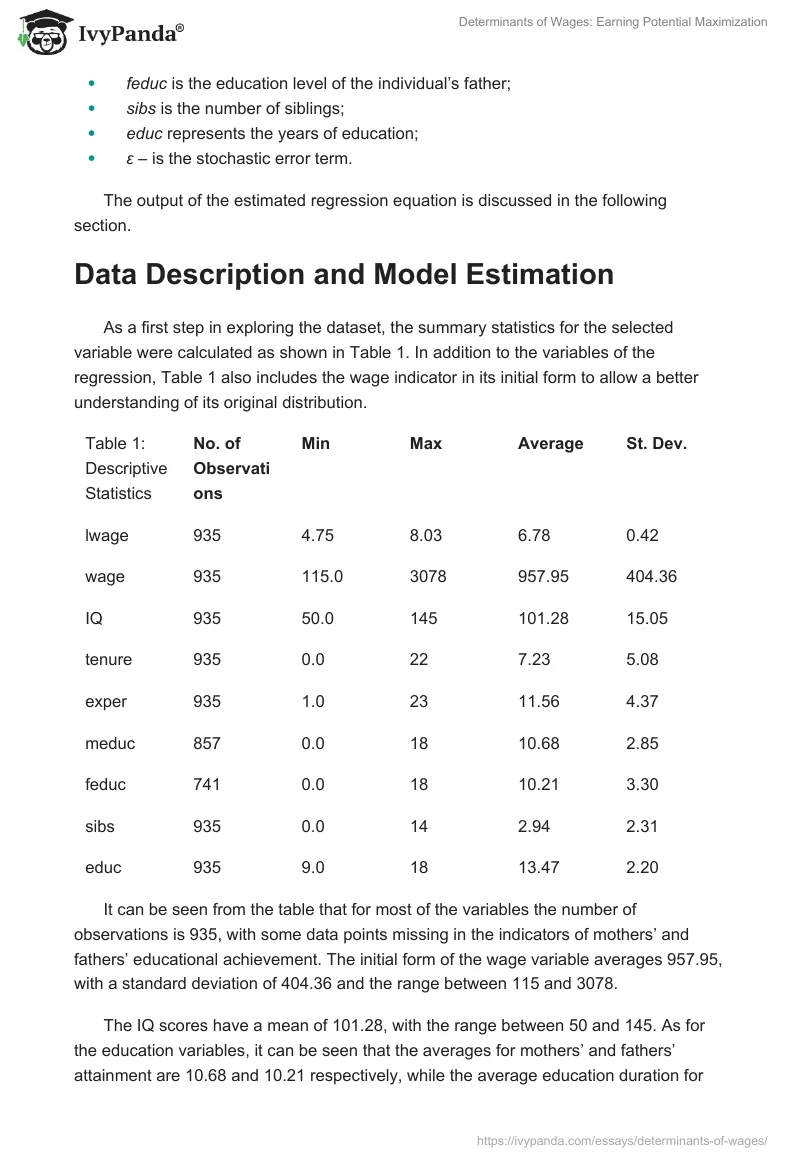Introduction
Exploring the set of factors that determine today’s wages is important to the extent to which it affects the patterns of time investment of citizens. In the current report, the analysis will be focused on defining the wage determinants highlighted in a specific dataset. The results of the calculations can then provide valuable insights on what moves the modern wages, as well as guidance for better related strategic choices – for instance, getting an additional year of education, or an extra year of direct work experience. As a result, the conclusions determined in the following research can drive more informed decisions for individuals searching to maximize their earning potential.
Econometric Model
The econometric model chosen to analyze the research questions of interest is the multiple regression method. The left-hand side of the equation is represented by the logarithmic transformation of the variable of wages. This form of the variable provides an easier interpretation of the regression outcome, as we are interested in percentage shifts in this indicator rather than per-unit changes. The right-hand side is represented by seven independent variables, and the full model is shown below:
lwage = β0 + β1 * IQ + β2 * tenure + β3* exper + β4* meduc + β5* feduc + β6* sibs + β7* educ + ε, where
- β0 is a constant term of the regression equation;
- lwage is a natural logarithm of the variable wage (amounts of monthly earnings of the respondents);
- IQ is the IQ score levels;
- tenure is the number of years with the current employer;
- exper is the years of work experience;
- meduc is the education level of the individual’s mother;
- feduc is the education level of the individual’s father;
- sibs is the number of siblings;
- educ represents the years of education;
- ε – is the stochastic error term.
The output of the estimated regression equation is discussed in the following section.
Data Description and Model Estimation
As a first step in exploring the dataset, the summary statistics for the selected variable were calculated as shown in Table 1. In addition to the variables of the regression, Table 1 also includes the wage indicator in its initial form to allow a better understanding of its original distribution.
It can be seen from the table that for most of the variables the number of observations is 935, with some data points missing in the indicators of mothers’ and fathers’ educational achievement. The initial form of the wage variable averages 957.95, with a standard deviation of 404.36 and the range between 115 and 3078.
The IQ scores have a mean of 101.28, with the range between 50 and 145. As for the education variables, it can be seen that the averages for mothers’ and fathers’ attainment are 10.68 and 10.21 respectively, while the average education duration for the sample participants themselves is 13.47 years. The average tenure with the current employer is 7.23 years, while the overall average experience of the respondents is 11.56 years. Lastly, the number of siblings of the sample participants ranges from 0 to 14, with an average of 2.94.
Table 2 summarizes the calculations made according to the regression equation. The value of the associated R-squared is 0.191, which means that close to 19.1% of the variation in the dependent variable (lwage) is explained by the dynamics of the set of independent variables. Overall, 5 of the 7 selected independent variables were found to be significant, and the insignificant 2 were the number of siblings and mother’s education. While the result for the number of siblings appears intuitive, mother’s education could be found insignificant because it may be correlated with the father’s education variable.
The number of years of tenure was found to positively influence wages, with 1 year higher tenure associated with 1% higher wages, the result being significant at 99% (the p-value is 0.001). In comparison, the years of experience, seem to have an even higher positive impact on wages, with 1 additional year of experience associated with 1.9% higher wages all else being equal, at a 99% level of significance (0.000 p-value).
As for the education, 1 more year of education is associated with on average 4.8% higher wages, significant at 99% (p-value of 0.000). One additional point of IQ was found to drive wages 0.5% higher all else being equal (p-value of 0.001). Lastly, the indicator of father’s education was found to be marginally significant at 90% (with the p-value of 0.057), with every additional year bringing on average a 1% increase in wages. The sign and magnitude of each of these indicators can be considered intuitive, and consistent with common-sense assumptions.
Conclusion
In summary, based on above estimation, it is possible to see that the highest contribution to an individual’s wages is made by the variable of education. This means that all else being equal, additional years of education should be preferred to years of experience or tenure at a specific company (4.8% per year contribution versus 1.9% and 1%, respectively). Moreover, higher IQ and father’s education can also have a positive impact on the salary potential.
However, it is also important to take into account some of the possible drawbacks of the estimated model. First, the R-squared of 19.1% implies that certain variables relevant to explaining the wage dynamics could be not included in the analysis, thus introducing the possibility of the omitted variable bias. Some indicators that may have been omitted include, for instance, the industry dummy variables or the levels of self-reported health.
In addition, the high correlation between the variables of father’s and mother’s education (0.576) could have introduced some degree of multicollinearity into the model, which means that the respective coefficients could be estimated imprecisely. Lastly, the model could also be improved by introducing the interaction terms into the equation. For instance, the interactions of “finance industry * education” and “retail industry * education” could measure the returns to additional years of education in these specific industries. Overall, the estimated model provides a good starting point for analysis of the set of relevant wage determinants, as well as their possible implications for the optimal allocation of time and financial resources for those who strive to achieve the maximum attainable income.


